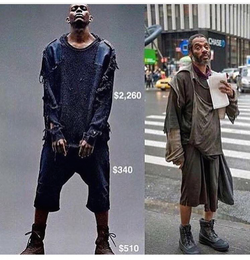A
AlwaysLost
Guest
HOMELESS INSPIRED FASHION COLLECTION SPARKS DEBATE AT MEN'S FASHION WEEK
Looks from the N. Hoolywood Collection
Randy Brooke/WireImage (3)
3:50 PM PST 2/1/2017 by Sam Reed
N. Hoolywood designer Daisuke Obana had the fashion world buzzing on Wednesday.
Daisuke Obana, designer of Japanese menswear label N. Hoolywood, sparked quite the debate on Wednesday after sending his homeless youth-inspired fall 2017 collection down the runway at New York Men's Fashion Week.
While some critics (as well as homeless advocates) called the collection, "tasteless," "tone-deaf" and "insensitive," others, including The New York Times' Guy Trebay, were quick to point out "that the glass of fashion is mostly a reflective device." He added, "[the collection] served as a reminder of an often invisible population — one that, in light of recent studies showing that in almost no place in the United States can a person working a 40-hour week at minimum wage afford a one-bedroom apartment at fair market rent, seems destined to increase."
The N. Hoolywood collection, priced from about $55 to $500, sells online at East Dane, Yoox and other retailers. The designer has had past collaborations with Reebok.
READ MOREProtest Signs, Camo Prints Kick Off Men's Runway Shows at New York Fashion Week
Obana told Hype Beast ahead of his show that he was inspired when he "witnessed the ‘gutter punk’ subculture during my travels through America," and was impressed by their "inventiveness," and how a plastic bag can be used to carry possessions as well as serving as a waterproof shoe covering when it rains.
To emphasize the inspiration, street-cast models were apparently told to hit the catwalk with their eyes downcast, and, as Trebay put it, wear "dazed expressions that made some look as though they had forgotten to take their meds."
Fashionista's Steve Dool wrote in his review that the collection was "like a fetishized version of homelessness. The clothes individually were luxurious and expensive. … The N. Hoolywood homeless man is a sanitized, polished type of homeless." He added that Obana's vision was "either condescending, ignorant, almost inconceivably out of touch or some hellish combination of all three."
Vogue's Lee Carter had a different take, viewing the collection as more of a warning. "Given that Obana has previously tackled sensitive subjects, namely climate change, maybe he’s having another prescient moment here, envisioning a future where homelessness isn’t a taboo but the norm, a world where everyone stuffs their pants with all their earthly possessions and unironically totes around plastic trash bags (that can double as waterproof boots, according to the program notes). When pressed, he did say via translator that while working on the collection he thought about how the world is changing so fast, and not always for the better."
The appropriation of homeless street culture is nothing new in the fashion world. John Galliano was roasted for presenting a homeless-inspired collection in 2000, which allegedly served as the inspiration for Mugatu's "Derelicte" collection in Zoolander when the film debuted in 2001. "It is a fashion, a way of life inspired by the very homeless, the vagrants, the crack whores that make this wonderful city so unique,” said the film's villain in an obvious satire of Galliano.
In 2010, Vivienne Westwood resurrected the theme with a collection which, as the press notes stated, included “quilted bombers and snug hoodies that also work well in keeping the vagrant warm.”
Style Notes: Maya Rudolph, Fred Armisen Star in Kenzo Campaign; Gigi Hadid's Makeup Artist Lands Maybelline Deal
FASHION WEEKBEAUTYRED CARPETRETAIL REPORT
© 2017 Pret-a-Reporter. All Rights Reserved.
TERMS | PRIVACY | SITEMAP | ABOUT OUR ADS




